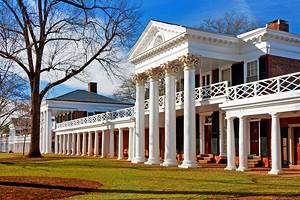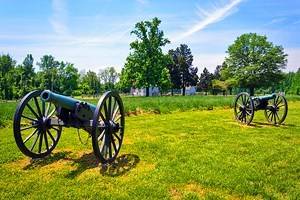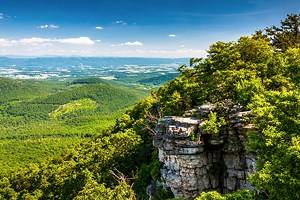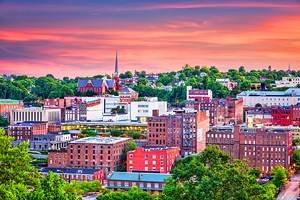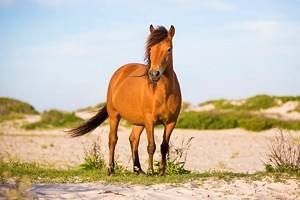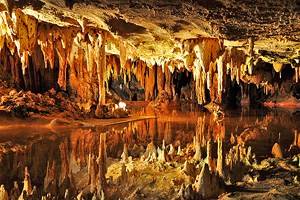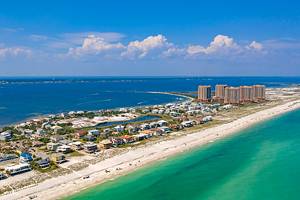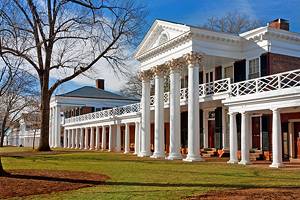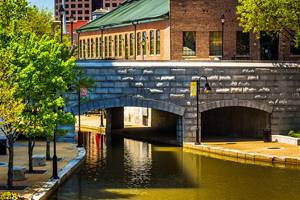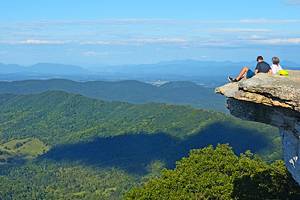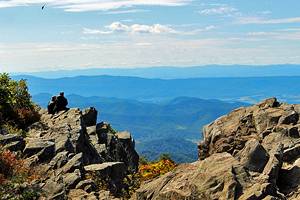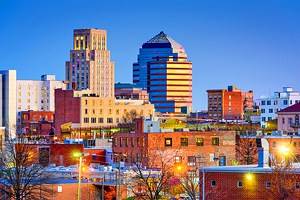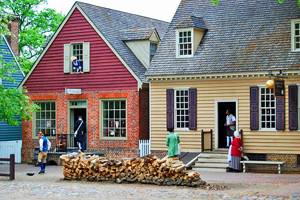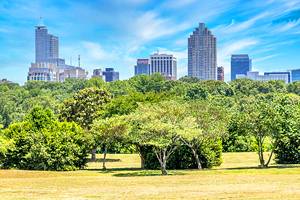Tourist Attractions in Virginia
History is everywhere in Virginia. Four of the first five presidents were born in the state, giving it a head start on the record of eight, the most of any state. Two of its top tourist attractions – Mount Vernon and Monticello – are homes of presidents. Virginia also claims the most Civil War battlefields of any state and the places where both the Revolution and the Civil War ended.
The colonial capital of Williamsburg, now restored to its 18th-century appearance, was among the hotbeds of the Revolution. But it's not just history that brings tourists here. Visiting the state's natural wonders, including Luray Caverns, Natural Bridge, the barrier islands of Chincoteague and Assateague, and Shenandoah National Park, are some of the top things to do.
The mountains are prime places to visit for hiking and other outdoor sports, and the long golden beaches are popular summer destinations. Plan your visit to this fascinating state with our list of the top attractions in Virginia.
- Shenandoah National Park and Skyline Drive
- Colonial Williamsburg
- Virginia Beach
- Arlington National Cemetery
- Mount Vernon
- Monticello and Charlottesville
- Jamestown and Yorktown
- Maymont
- Virginia Museum of Fine Arts
- Luray Caverns
- Busch Gardens
- The Battleship Wisconsin & Nauticus
- Steven F. Udvar-Hazy Center
- Richmond
- Natural Bridge of Virginia
- Chincoteague and Assateague Islands
- Virginia Aquarium & Marine Science Center
- Manassas National Battlefield
Shenandoah National Park and Skyline Drive
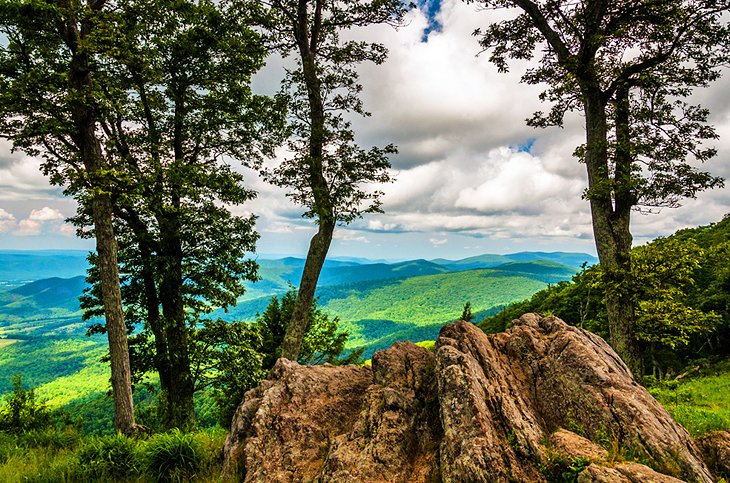
In the center of Virginia, Shenandoah National Park protects portions of the Blue Ridge Mountains, which range in height between 2,000 and 4,000 feet. Along their crest and running the length of the park is the Skyline Drive, the northern continuation of the Blue Ridge Parkway, with stopping points to enjoy the views and attractions, including President Hoover's summer residence and the old Cave Cemetery below Dark Hollow Falls.
The beautiful hiking trails are some of the park's main attractions. Flowering trees and shrubs are at their finest in spring and summer, but the park is best known for its autumn colors in October. Only a short drive west from the Skyline Drive on US 211 are Luray Caverns containing magnificent formations of stalactites and stalagmites.
Colonial Williamsburg

Few places can recreate a setting for the period of the American Revolution as well as Williamsburg, where the original 18th-century buildings are either still standing or have been faithfully reproduced on their original foundations. Here, you can stand where Patrick Henry gave his stirring speech, walk the same streets as Thomas Jefferson, and savor a meal where George Washington enjoyed seafood dinners.
Williamsburg was the capital of Virginia from 1705 and throughout the Revolution, and the final battle of the war was fought nearby, so it was a hotbed of the independence movement, along with being one of the most prosperous and politically active colonial capitals.
Costumed interpreters help show what life was like for the gentry, the farmers, and the slaves that lived and worked here, and frequent re-enactments add color and action that makes Williamsburg a fun place to visit for all ages. In addition, you can visit two outstanding museums of folk and decorative arts and dozens of authentically recreated colonial gardens.
Virginia Beach
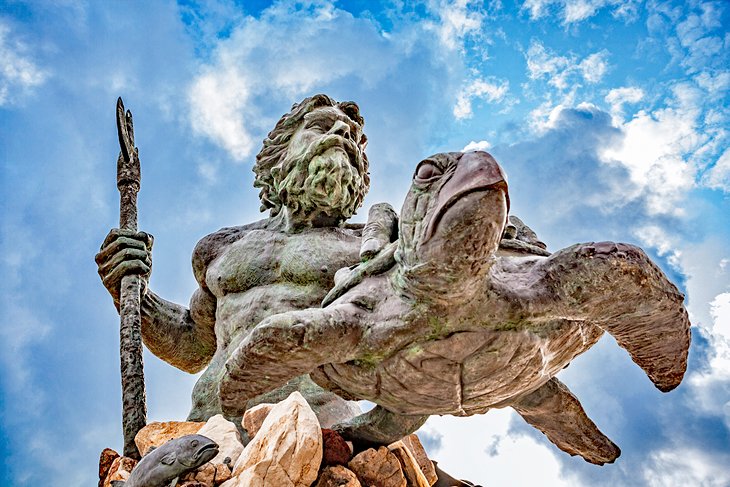
Named for the wide expanse of golden sand that stretches from just east of Norfolk, Virginia Beach is a very popular and often crowded resort town with the expected hotels, amusements, and a long boardwalk. If the Atlantic Ocean is not warm enough for the children, take them to the 19-acre Ocean Breeze Water Park, with Caribbean-themed waterslides, a wave pool, and water playground.
The Virginia Aquarium and Marine Science Museum explores the climate, sea floor, and fauna of the coast, with an 800,000-gallon aquarium, hands-on exhibits, and a touch tank. Outdoors is an aviary, nature trail, marshlands to explore, and an adventure park.
More than 9,000 acres of coastline has been protected in the Back Bay National Wildlife Refuge, where you'll find walking and hiking trails and picnic facilities at the visitor center. This is a favorite spot for birders, as more than 10,000 birds visit annually, including snow geese, falcons, ducks, and piping plovers.
The Atlantic Wildfowl Heritage Museum displays historical and contemporary waterfowl decoys. To visit the 1791 Old Cape Henry Lighthouse, which opened up the Chesapeake Bay area to safe navigation, and the nearby New Lighthouse built in 1881, you will need to pass through security at the Fort Story Military Base.
Between Virginia Beach and Norfolk is the entrance to the 20-mile-long engineering marvel Chesapeake Bay Bridge-Tunnel, which spans the entrance to Chesapeake Bay, connecting the mainland to Virginia's Eastern Shore.
- Read More: Tourist Attractions in Virginia Beach
Arlington National Cemetery
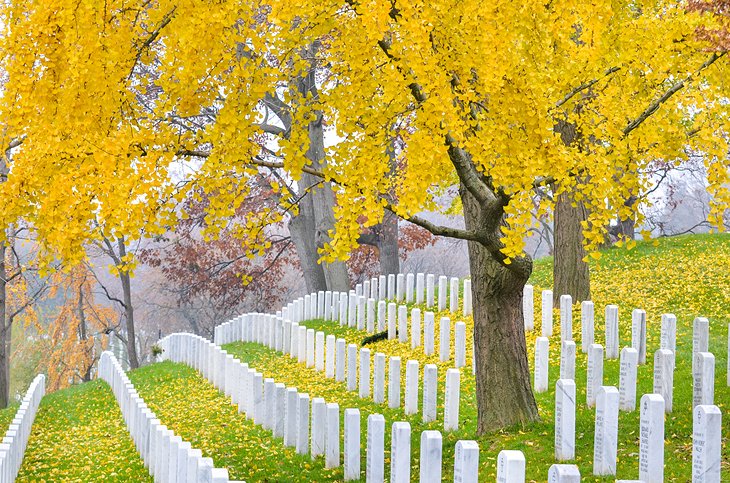
Spread across 600 acres overlooking Washington, D.C., Arlington National Cemetery is where some of the most famous people in the United States are buried. The most visited are the grave of President John F. Kennedy and the Tomb of the Unknown Soldier. Kennedy's grave is marked by a slate headstone covered with Cape Cod fieldstone and contains inscriptions of his 1960 inaugural address carved in marble, as well as an eternal flame.
The Tomb of the Unknown Soldier is carved of white marble and watched over by an honor guard 24 hours a day, seven days a week, 365 days a year. It contains the remains of soldiers from both World Wars, the Korean Conflict, and the Vietnam War.
The third site tourists look for is the famous Iwo Jima Memorial, the Marine Corps War Memorial depicting the Joseph Rosenthal photo of five marines and one sailor raising the flag on Mount Suribachi. Other notable monuments include the Seabees Memorial, sculpted by former Seabee Felix de Weldon who also created the Iwo Jima Memorial, and the Women in Military Service for America Memorial, a tribute to all women in the US military.
Arlington House was built in the early 1800s by George Washington Parke Custis as a tribute to his step-grandfather, George Washington. However the house is most famous for being the residence of Robert E. Lee and his wife for 30 years until they abandoned it during the Civil War.
Lee was commander of the Confederate Army of Northern Virginia during the American Civil War. The house has been restored and now serves as a memorial to him. Near the mansion is the tomb of Pierre L'Enfant, who designed the city of Washington, D.C. His original city plan is etched in stone, and his burial spot commands a beautiful view of the city he planned.
The mast of the Battleship Maine is incorporated into a memorial to the casualties of the ship that sunk in Havana Harbor in 1898, leading to the Spanish-American war.
Mount Vernon
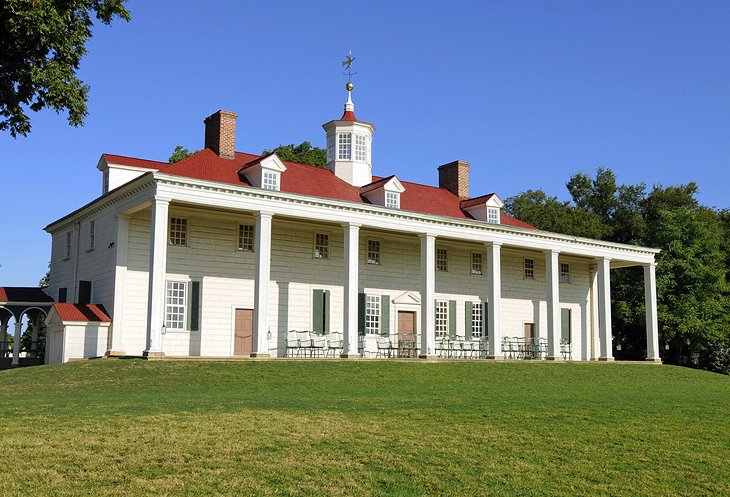
George Washington's home from 1754 until his death 45 years later, Mount Vernon was a work in progress under Washington's close supervision, even while he was leading the Continental Army during the Revolution. The architectural design, construction, and even interior décor in each renovation and addition received his personal attention, resulting in the gracious 21-room plantation house you see today.
You may be surprised at the vivid paint and wallpaper colors throughout the house, but these shades were popular in the late 18th century - the bright green walls in the "New Room" were Washington's favorite. Unlike many historic homes, Mount Vernon is filled with personal reminders of George and Martha Washington: family portraits, crests, and the couple's belongings.
The grounds and gardens overlooking views of the Potomac River were a great pride of the first president, and again he took a personal part in their planning and care. He chose a less formal and more natural plan than his predecessors, reshaping the lawns and paths and planting native species of trees and shrubs.
The outbuildings have been preserved or reconstructed, and you'll often see the many skills used on the plantation demonstrated: blacksmithing, plowing, sheep shearing, weaving, even grinding grain at the water-powered gristmill.
Address: 3200 Mount Vernon Memorial Hwy, Mount Vernon, Virginia
Official site: www.mountvernon.org
Monticello and Charlottesville
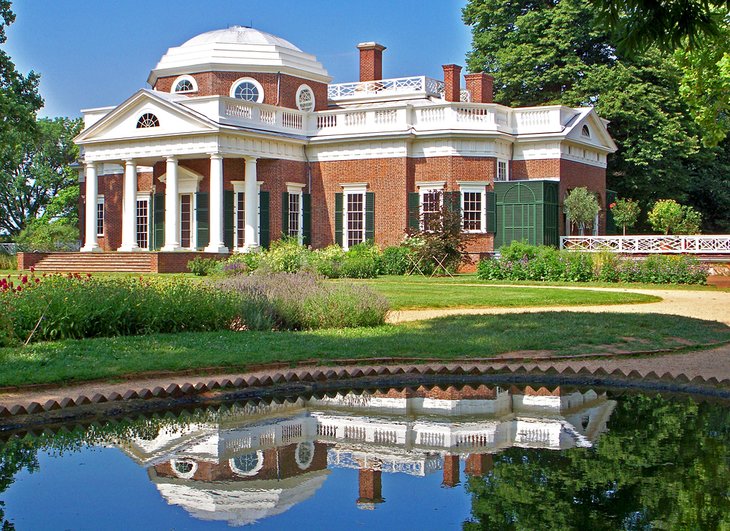
One of the finest country houses in the United States and one of the most visited presidential homes, Thomas Jefferson's Monticello is a Palladian-style mansion he designed himself, inspired by a villa outside Vicenza, Italy. He continued altering and improving it over a period of forty years, from 1768 to 1809.
Throughout the house, you'll see several of Jefferson's inventions, which show another facet of the versatile man's talents. To the rear of the house are the extensive historic gardens, also designed by Jefferson, and below is the family cemetery with an obelisk marking Jefferson's grave.
An interesting outdoor exhibit, Landscape of Slavery: Mulberry Row at Monticello, sheds light on the lives of the people who worked and lived on the 5,000-acre plantation. The Monticello Visitors Center has more than 400 items on display, an introductory film, and hands-on activities for children.
Jefferson founded the University of Virginia in 1819 and also designed its red-brick buildings. Be sure to see the outstanding Rotunda; fans of Edgar Allan Poe can see his room in the West Building. The university's Art Museum has a permanent collection of American, European, and Asian art.
Not far from Monticello is Highland, the country house of President James Monroe, with beautiful period gardens. At Michie Tavern, built during Jefferson's time, you can dine in 18th-century surroundings.
Address: Thomas Jefferson Parkway, Charlottesville, Virginia
Official site: www.monticello.org
- Read More: Things to Do in Charlottesville
Jamestown and Yorktown
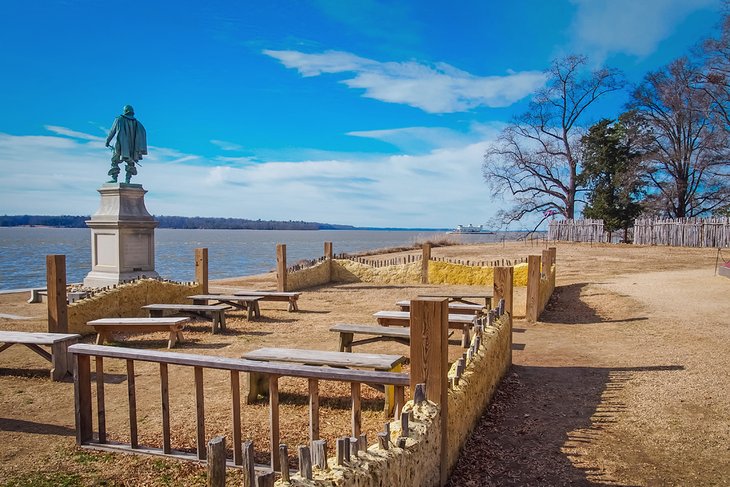
Colonial National Historic Park encompasses both Jamestown and Yorktown, where the Revolution ended. Jamestown is the oldest British settlement on North American soil, established in 1607 by Captain John Smith.
Only the foundations of the 1639 church tower, the churchyard, and the outlines of a few other buildings remain of the original settlement, but you'll find a re-creation of a Powhatan village based on contemporary drawings and archaeological finds, and replicas of the three ships that brought the settlers from England: Susan Constant, Godspeed, and Discovery.
Jamestown Settlement was built in 1957 to commemorate the 350th anniversary of Jamestown's founding. A museum and exhibition galleries focus on England's colonization in the New World, the history and culture of the Powhatans, and Jamestown's first 100 years.
The statue of Pocahontas by William Ordway Partridge was erected in 1922 in memory of her role in smoothing relations between the Native Americans and the settlers. The statue of John Smith by William Couper was erected in 1909.
Triangular James Fort is a re-creation of the one constructed by the colonists, with thatch-roofed structures representing Jamestown's earliest buildings. Although none of the original buildings are still standing, the foundations are still in place, and you can see them on a half-mile walk through New Towne, part of Colonial National Historical Park.
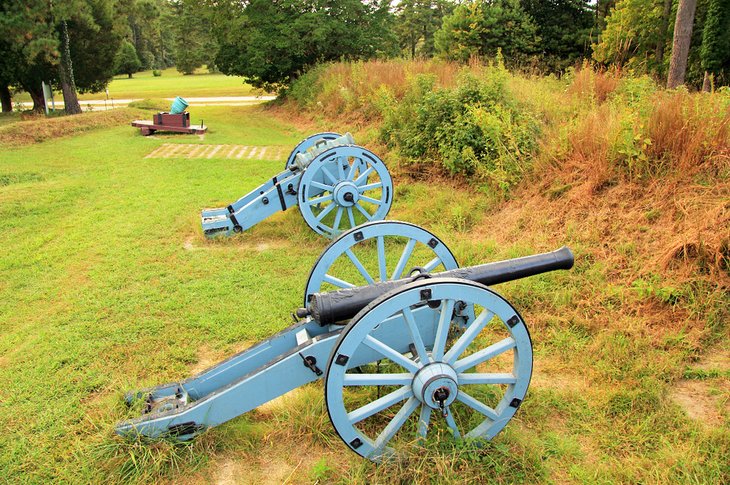
It was at Yorktown Battlefield that the English Army under Lord Cornwallis surrendered to the combined American and French Armies, paving the way for American Independence. The events on the battlefield are well documented and easy to understand from the interpretive displays and dioramas. Park Ranges also guide frequent tours, and you can see the early 18th-century Moore House where Cornwallis surrendered.
Nelson House, which has a cannonball lodged in the wall near the upper window, is well-restored and an excellent example of Georgian architecture. Grace Episcopal Church has been standing since 1697 despite the ravages of war during the sieges of Yorktown in 1781 and 1862 and despite the fire of 1814. Communion silver dating from 1649 is still in use.
Address: Colonial National Historical Park, Yorktown, Virginia
Maymont
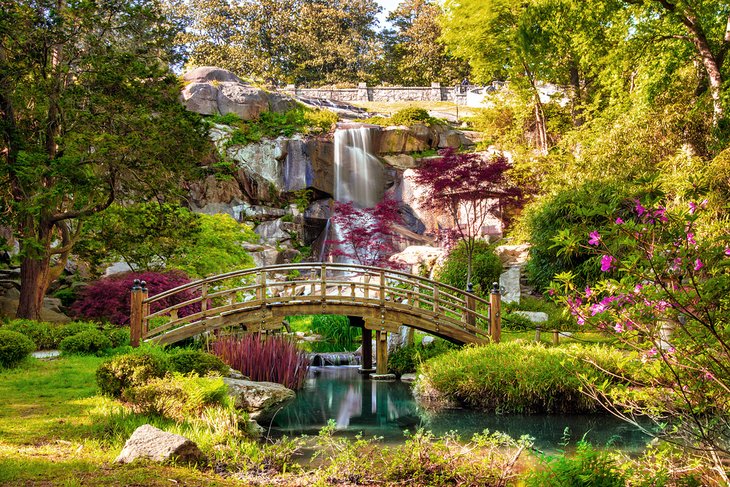
Walking through the landscaped and manicured gardens of Maymont, It is hard to imagine this 100 acres as the pastures and fields of the dairy farm it was before James and Sallie Dooley acquired it in 1886.
The opulent mansion was completed in 1893 and for the next 30 years, Mrs. Dooley worked with a team of top landscape designers and horticulturalists to surround it with gardens and an arboretum, turning into a showpiece worthy of any Gilded Age millionaire.
Hundreds of rose bushes, beds of annuals, and perennial borders bloom throughout the seasons, and exotic trees from around the world shade garden paths. Highlights are the Japanese Garden and the spectacular terraced Italian Garden, with its fountains, cascade, pergola, and stonework of Petersburg granite. The mansion is a blend of Romanesque Revival and Queen Anne styles, its restored interior complete with original furnishings and collections from the Dooleys' travels.
Address: 1700 Hampton Street, Richmond, Virginia
Official site: https://maymont.org/
Virginia Museum of Fine Arts
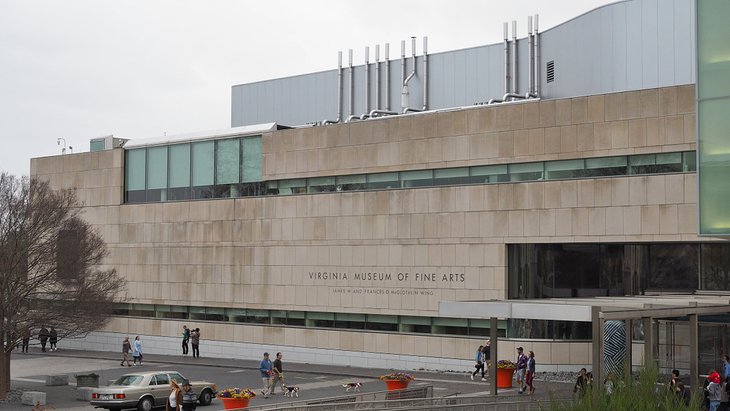
The more than 22,000 works in the Virginia Museum of Fine Arts are largely focused on modern and contemporary art, especially European art after 1900, American art after 1950, and 21st-century art worldwide. Within that, several special collections stand out.
The Ludwig and Rosy Fischer Collection of German Expressionist Art includes works in all mediums - paintings, woodcuts, etchings, and lithographs - with a particular focus on the Die Brücke artists. The growing collections of works reflecting African American experience and expression includes works by African, African American, and African Diaspora artists.
A suite of five galleries display the largest public collection of Fabergé and Russian decorative arts held by an American museum, including silver, enamels, and an exceptional group of five Fabergé easter eggs made for the last two Russian czars.
Other noteworthy collections feature Art Nouveau and Art Deco works; French Impressionist and Post-Impressionist art; and significant holdings of African, Asian, ancient, pre-Columbian, and Native American art.
Address: 200 N Arthur Ashe Blvd, Richmond, Virginia
Official site: https://www.vmfa.museum
Luray Caverns
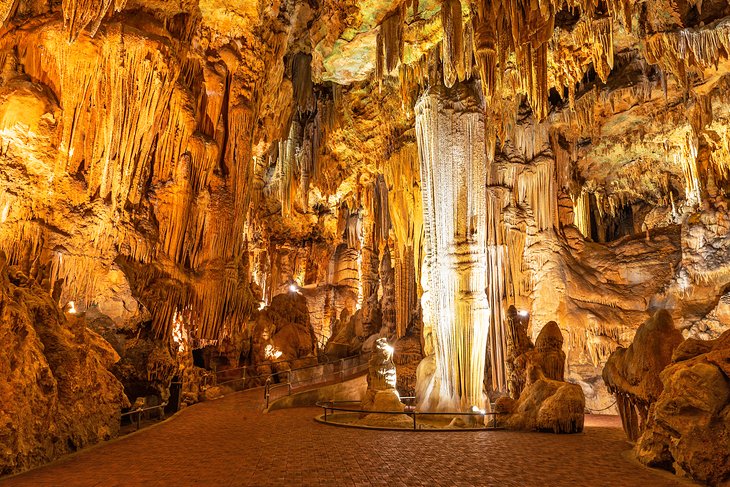
Luray Caverns contain breathtaking examples of calcite formations within an extensive underground system that sometimes feels more like an alien landscape than a terrestrial natural landmark. Visitors can walk through the caves and admire these limestone crystals, which have, over the centuries, formed an impressive landscape.
Among the highlights are Titania's Veil; the giant Double Column; interior lakes, which magnify the scene; and a one-of-a-kind musical instrument called the Great Stalacpipe Organ, which creates music using the stalactites themselves.
In addition to the caves, visitors can also enjoy other attractions as part of the admission. The Luray Valley Museum explores the history of the Shenandoah Valley throughout a seven-acre 19th-century village, which is filled with both authentic and reproduction buildings and artifacts. The Car & Carriage Caravan Museum features historic vehicles, including an 1897 Mercedes Benz, and Toy Town Junction is home to an antique train set and toy collection form the 1940s.
Address: Luray Caverns, 101 Cave Hill Road, Luray, Virginia
Official site: https://luraycaverns.com
Busch Gardens
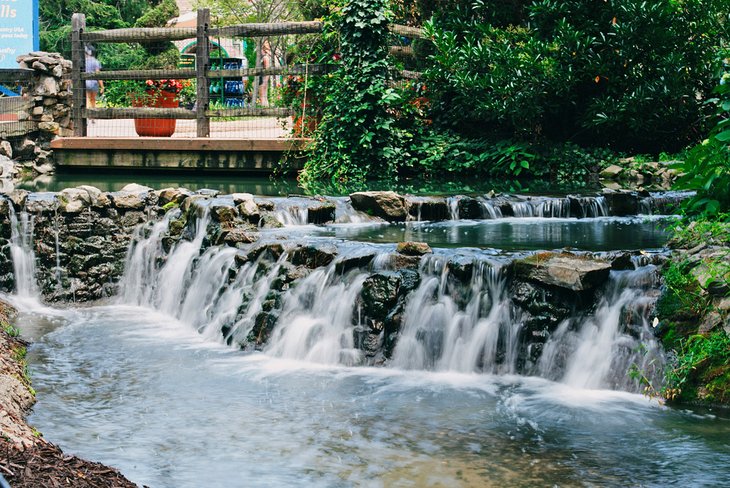
Taking Europe as its theme, this lively adventure park evokes southern Germany in its entertainment area with dirndl-costumed dancers and a traditional Bavarian band, while rides and roller coasters themed to the Loch Ness Monster, the Alps, and the ruins of Pompeii provide thrills for the whole family.
For quieter moments, you can watch Border Collies herd sheep as they do in Scotland or share time with exotic birds in an interactive aviary. Special sections are designed for younger children, with rides appropriate to their thrill level.
Address: One Busch Gardens Boulevard, Williamsburg, Virginia
Official site: https://buschgardens.com/
The Battleship Wisconsin & Nauticus
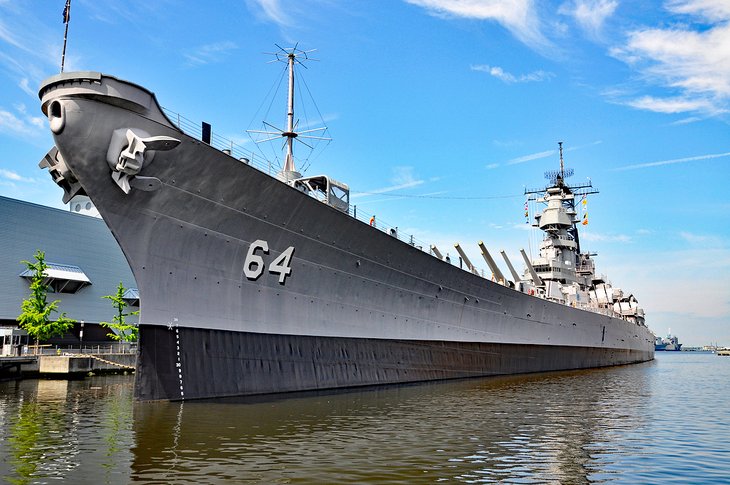
One of the largest ever built by the U.S. Navy, the Battleship Wisconsin is also one of the last launched in December of 1943 at the Philadelphia Navy Yard. World War II was at its height, and the Wisconsin was immediately deployed to the Pacific, into the midst of some of the heaviest sea combat of the war, earning five battle stars.
Mothballed after the war, the Wisconsin was recommissioned for the Korean War, and in 1951 became the flagship of the Seventh Fleet in the Pacific. On a self-guided tour, you can visit the deck, or explore further on a tour guided by former Navy personnel.
The Wisconsin is berthed at Nauticus, a maritime discovery center with interactive exhibits and programs that also includes the Schooner Virginia, a sailing center, and museum. In December, Winterfest sees the Wisconsin covered in colored lights.
Address: 1 Waterside Drive, Norfolk, Virginia
Official site: https://nauticus.org
Steven F. Udvar-Hazy Center
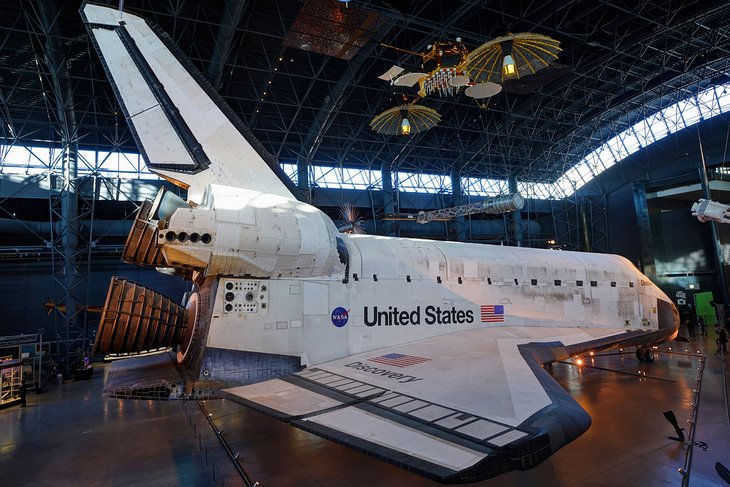
The Steven F. Udvar-Hazy Center is an extension of the Smithsonian's National Air and Space Museum in Washington, D.C., and is home to thousands of artifacts and aircraft which inspire awe in visitors. Perhaps the most impressive of these is the Space Shuttle Discovery, the centerpiece of the space science exhibits.
Within two immense hangars, the center houses a wide variety of aircraft which represent every aspect of aviation, from the earliest years of flight through modern commercial craft, including a Concorde on display.
Other aircraft include examples of both U.S. and foreign military vehicles from the WWII era as well as military craft and technology from the Korean and Vietnam wars, the cold war, and modern military craft. The museum is also a working restoration center, and visitors can watch staff from a mezzanine as they repair and preserve more artifacts and craft.
The center is also full of interactive exhibits and demonstrations, including the unique Discovery Stations which as mobile exhibits manned by staff who are ready to answer questions and engage younger visitors. The center's IMAX theater presents a range of films about aviation and space exploration, history, and nature.
Aspiring aviators and amateurs will want to take flight in an interactive flight simulator, and those hoping for an adventure will want to hop aboard the motion capsule ride simulator which offers a range of themed immersive experiences.
Address: 14390 Air and Space Museum Parkway, Chantilly, Virginia
Official site: https://airandspace.si.edu/udvar-hazy-center
Richmond

Among the skyscrapers of Virginia's modern capital city are some reminders of Richmond's great past as a center of the American independence movement and capital of the Confederacy from 1861 to 1865. The imposing State Capitol was built in 1785-1788, designed by Thomas Jefferson, and to its south is the start of Canal Walk, which runs along the James River-Kanawha Canal, built at the suggestion of George Washington.
The Church Hill Historic Area preserves about 70 antebellum houses that give some impression of what Richmond was like before the Civil War. The district is named after St. John's Episcopal Church in which Patrick Henry made his famous "Give me liberty or give me death" speech. The 1737 Old Stone House is the oldest building in Richmond, now housing the Edgar Allan Poe Museum (Poe lived in Richmond for several years).
Richmond National Battlefield Park illustrates more than five years of campaigns to capture this key city during the Civil War. That era is also illustrated at the White House of the Confederacy, restored to its wartime appearance and displaying hundreds of Civil War artifacts.
Several of the historic homes are of particular interest: John Marshall House is one of the few remaining Federal homes built in this area and is filled with the distinguished Supreme Court Justice's family relics and furniture.
The Wilton House Museum is a beautifully restored plantation home built in the mid-18th century, and Maymont is an elaborate mansion restored to show the grandeur of life here in the late 1800s. Its extensive gardens include an arboretum and 100-acre park with a carriage collection.
- Read More: Tourist Attractions in Richmond, VA
Natural Bridge of Virginia
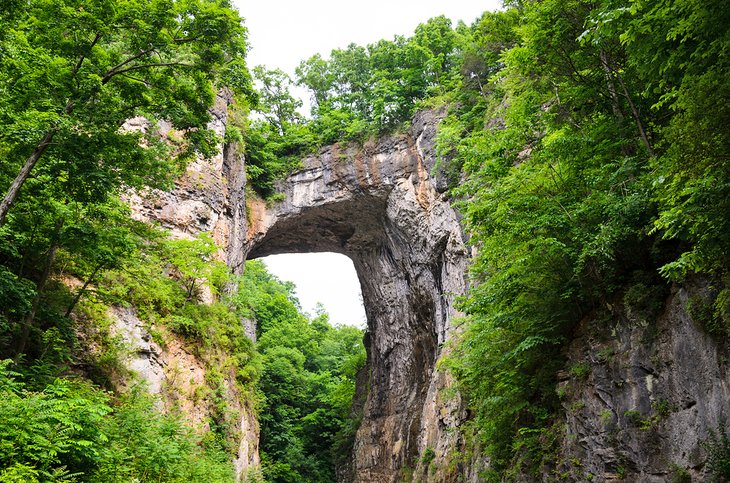
Towering more than 215 feet high with a span of 90 feet, the Natural Bridge is one of America's oldest tourist attractions and is listed on the National Register of Historic Places. During the 18th and 19th centuries, it was one of the two most popular sights for European visitors, ranking with Niagara Falls.
It was formed by the collapse of a cavern through which the Cedar Creek flowed. The legend that George Washington surveyed the bridge for Lord Fairfax gained credence when a rock with his initials and survey mark was discovered in 1927. Thomas Jefferson owned the land for some time, building a log cabin here as a retreat.
In 2014, Natural Bridge became a state park. Stroll along Cedar Creek Trail from Cascade Falls, under the bridge, and to Lace Falls, visiting an exhibit on the Monacans, the local Native American tribe, and a saltpeter mine used during the Revolutionary War and the War of 1812. US Route 11 runs over the top of the bridge.
Nearby are Natural Bridge Caverns, where you can go 34 stories underground to see the Colossal Dome room, Mirror Lake, and the stalactites and stalagmites. Natural Bridge Zoo is known for its work in breeding rare and endangered species and for the chance for visitors to interact with some of the animals.
Address: 6477 South Lee Highway, Natural Bridge, Virginia
Chincoteague and Assateague Islands
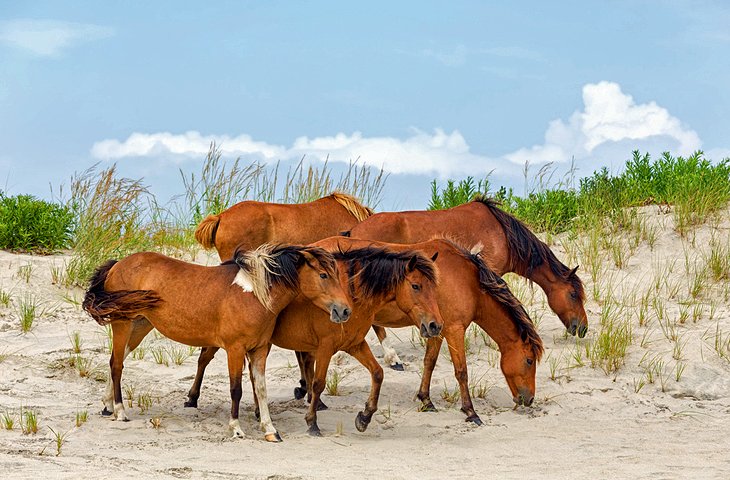
Assateague is a 38-mile-long barrier island to the east of Chincoteague Island, which it protects from the Atlantic Ocean. The entire island of Assateague, which is partly in Maryland and partly in Virginia, is protected as a wildlife sanctuary.
The southern end of Chincoteague is protected by a National Wildlife Refuge with 14,000 acres of shoreline, fresh and saltwater marshes, wetlands, and forest habitat for more than 320 species of shorebirds and waterfowl.
But the two islands' most famous residents are the wild ponies. Partly because of these ponies and partly because Assateague Island is lined by one of the most beautiful beaches on the entire Atlantic Coast, these islands get about one-and-a-half million visitors each year.
Along with watching the wild ponies, you can swim, walk nature trails, take wildlife tours by boat or bus, watch birds, visit the famous lighthouse, kayak, go fishing, and collect seashells (up to a gallon each day).
- Read More: Tourist Attractions in Norfolk, Virginia
Virginia Aquarium & Marine Science Center
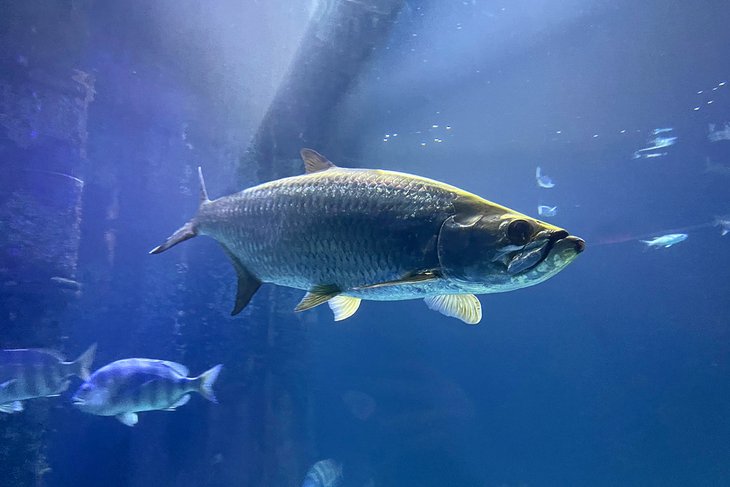
The Virginia Aquarium and Marine Science Center provides a wide range of exhibits and activities for the entire family and is one of the most popular family attractions in Virginia Beach.
Aquarium residents include several varieties of turtle, including Loggerhead Sea Turtles and Green Sea Turtles, water-dwelling reptiles like Komodo dragons and tomistoma, predators including sandbar sharks, and entertaining mammals including harbor seals and otters. The center also has a variety of educational exhibits and activities for all ages, as well as a six-story theater, which has regular showings of 3-D nature films.
For those who want a more interactive experience with nature, there are outdoor recreation options as well, including a six-acre zipline adventure park for ages five and up. All ages can enjoy one of the center's various boat excursions, which spot wildlife including bottlenose dolphins, a variety of whales, and many types of sea birds.
Address: 717 General Booth Blvd., Virginia Beach, Virginia
Manassas National Battlefield
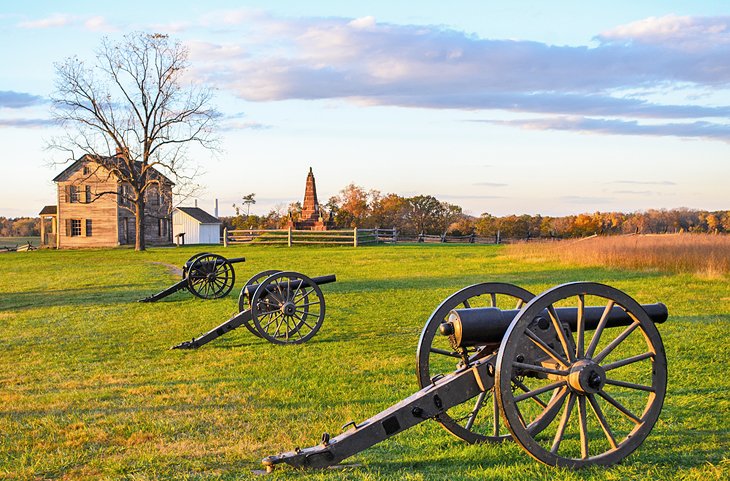
Two key battles in the Civil War were fought near Manassas, Virginia in 1861 and 1862. The site has been preserved as Manassas National Battlefield and is described exceptionally well, so visitors can understand and even picture those battles.
The first battle, also known as the Battle of Bull Run, was the first time the two armies clashed, and the second engagement on the plains of Manassas ended in a solid victory for the Confederates and marked the height of their strength in a war that would drag on for three more years.
Today, the park is not only a historic site but an important haven for more than 160 species of resident and migratory birds.
Address: 12521 Lee Highway, Manassas, Virginia
More Related Articles on PlanetWare.com
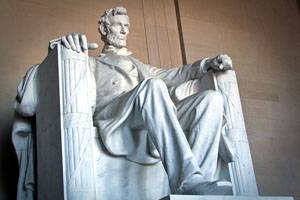
Washington, D.C.: Many of Virginia's most popular tourist destinations complement the historic and political attractions in and around Washington, D.C., a metropolis which has spread well into its neighboring states. In addition to iconic landmarks like the Capitol Building, the Washington Monument, and the Lincoln Memorial, the District of Columbia is home to some of the most legendary museums in the world, the Smithsonian Museums. This makes the nation's capital one of the most visited family destinations, and tourists can find a wide variety of places to stay in and around D.C.
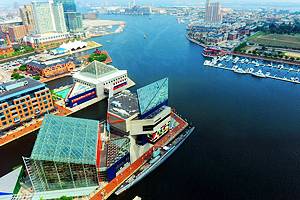
Maryland: The small coastal state of Maryland sits on the other side of the District of Columbia, bordering the capital city on three sides and sharing a long border with Virginia. It is home to the city of Baltimore, known for its extensive museums, historic landmarks, and cultural riches. Nearby, you will also find the smaller but charming Annapolis, which is full of things to see and do, from historic sites to spectacular sailing.
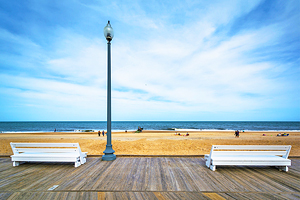
Delaware: Also within a reasonable drive from northern Virginia, the tiny state of Delaware provides a refreshing retreat along the Atlantic. Delaware is well known for its maritime history and cultural attractions, but equally popular for its abundance of fine beaches, revered for their calm waters along the protected shores of Delaware Bay. As a result, the state has become a top summer vacation destination for families and couples, and offers a variety of excellent resorts.


